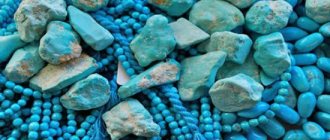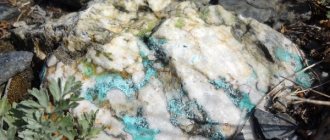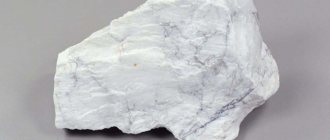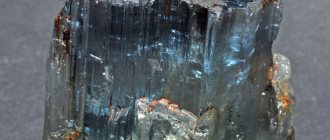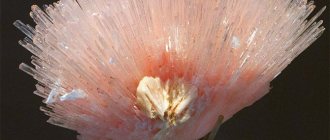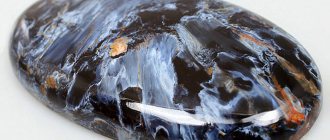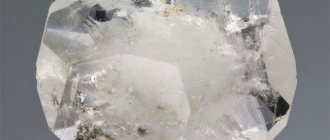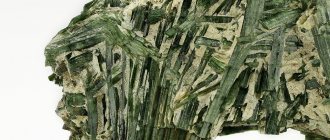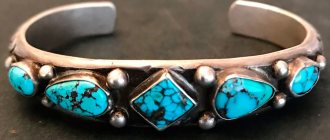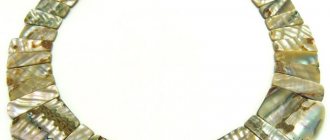What affects the color of a mineral? Is it possible to treat diseases with it? How to properly handle turquoise jewelry? You will learn about all this further.
History of the stone
Archaeological finds confirm that turquoise stone was popular in ancient times. In Ancient Egypt, jewelry was made from this mineral. Most often, craftsmen made scarab beetles. Such jewelry was worn not only for beauty, but also to attract positive changes in life.
Already in Ancient Egypt they knew about the magical properties of turquoise stone.
The gem was also found in the tomb of the most famous Egyptian ruler, Tutankhamun. Tutankhamun's sarcophagi were filled with all kinds of amulets and amulets accompanying the pharaoh on his final journey.
Scarabs still remain a popular amulet. Which means that among them there are often fakes. Be careful!
The stone was held in high esteem by Tibetan shamans and sorcerers. They used it in rituals of fortune telling for the future.
Russian rulers also appreciated the beauty and magical properties of the blue mineral. A throne decorated with a scattering of blue stones was delivered to Boris Godunov from the East. And Ivan the Terrible, according to legend, watched his favorite stone fade. And he claimed that this was a harbinger of his imminent death.
The stone received its familiar name (in the original “firuza”) in the 13th century. It is deciphered in different ways - a stone of happiness or a mineral of the winner.
Talismans and amulets
A great many legends and beliefs are associated with turquoise. In many of them, turquoise is associated with true love, the guardian of feelings and fidelity.
And the turquoise of lovers will fade when their love passes - these words belong to the famous 13th century Persian poet Saadi. They are closely related to the Persian belief that a bright blue stone received from the hands of a loved one symbolizes the strength and depth of her feelings. If it fades, it means that the feelings have faded and the beloved is lost forever.
Many rituals associated with love have come a long time ago and are still observed:
- The peoples of the Caucasus and Asia have an ancient tradition of decorating the bride’s wedding attire with turquoise.
- The Persians gave and still give the stone as a declaration of love.
- In Germany and Russia, it was customary to decorate wedding rings with turquoise to ensure a strong and happy marriage. Over time, this tradition was forgotten in these countries, but the Americans adopted it.
- The ancient Romans identified the stone with the goddess of love Venus and gave it to their soulmates as a sign of fiery feelings.
- Today, lovers continue to give each other things with turquoise, believing that they will help maintain love, fidelity and mutual understanding, as well as make it easier to endure separation and survive quarrels that arise.
This is interesting!
The belief that turquoise wards off misfortune from its owner is associated with the stories of a certain de Boot. He told the world that the stone saved his life twice. The first time, the young man, returning home at night along a narrow slippery road, fell out of the saddle, but escaped with only a slight fright, while a piece broke off from the talisman. The next time, the turquoise split in two, taking the blow upon itself. The guy was lifting a very heavy load, and he had severe pain in his chest, as if his ribs were broken or his muscles were torn. It turned out that he only suffered a slight sprain.
Modern magicians also unanimously argue that “Turkish stone” should be stocked up by people in dangerous professions, travelers and everyone involved in hard physical labor.
In Central Asia, from time immemorial, horse harnesses have been decorated with turquoise, doing this in order to protect riders from falls and other troubles while riding. Therefore, a bright blue stone should be purchased by all those who often ride horses - both professional jockeys and ordinary horseback riding enthusiasts.
It is also believed that the light blue variety is capable of expelling demons from a person. It is used as a talisman to protect against the influence of dark forces on human consciousness, including for children.
Turquoise is also an assistant to those who strive for power, but it will only allow truly worthy applicants, aimed at fighting evil and injustice, to achieve it.
To attract happiness, love and wealth, as well as to achieve spiritual perfection, it is worth purchasing a ring for a woman or a ring with turquoise for a man.
Turquoise deposits
The turquoise mineral was first discovered in the Sinai Peninsula (Egypt).
Historical sources provide varying information regarding the time period of mining. Some talk about 6000 BC, others talk about 3-4 millennia BC. The Sinai mines were abandoned during the decline of Egypt. Ancient Rome resumed mining of minerals. But then it was suspended again until the Middle Ages. Work is also underway there now.
Where else is turquoise mined:
- USA;
- Brazil;
- Mexico;
- Chile;
- Peru;
- Iran;
- Australia;
- Tanzania.
The first place in production has recently been occupied by the United States. Deposits are located in Arizona, Colorado, Nevada and California.
Why does stone lose color and deteriorate?
Like any piece of jewelry, turquoise requires proper care so that it retains its properties and color longer. Do not overheat the mineral or expose it to ultrasound, acids or abrasives for a long time. High-quality turquoise will be a wonderful addition to almost any outfit, but only when it is properly cared for.
After wearing, you need to put the jewelry in a dark place where ultraviolet light does not penetrate. It is strictly forbidden to treat the stone with cleaning agents; simply wipe with a dry cloth.
Physical and chemical properties
Turquoise is a white, blue or green mineral with characteristic black veins and small inclusions. The structure is not a crystal, but an agglomerate.
Some experts classify it as IV order of the first group of precious stones, while others believe that turquoise is a semi-precious stone.
The color of turquoise depends on the predominance of certain elements.
Physical and chemical properties:
- transparency is completely absent;
- hardness on the Mohs scale - 5-6;
- chemical formula – CuAI6(OH)2[PO4] 4H2O;
- shine - waxy, dull;
- density - 2.6-2.8 g/cm³;
- cleavage - perfect/imperfect;
- fracture - conchoidal, uneven.
In nature, the color of a mineral depends on the predominance of foreign impurities. Blue is obtained due to a large amount of copper, and green - with an increased concentration of iron.
MORPHOLOGY
The crystals are very rare and have a predominantly short-prismatic habit. Usually distributed in kidney-shaped cryptocrystalline masses or in the form of crusts, veins and irregularly shaped clusters. On the cut, it often has characteristic thin veins of black or brown color, the interweaving of which gives a beautiful mesh pattern (“mesh turquoise”). Sometimes it forms significant accumulations, cementing fragments of crushed breccias in the swellings of small shear cracks. It should be borne in mind that only certain areas of turquoise accumulations are composed of turquoise itself; the bulk of them is represented by an aggregate of turquoise and accompanying and replacing minerals, that is, as a rule, these are polymineral formations. Therefore, in each specific case, it is always with some convention that veins and other highlights of turquoise are spoken of.
Types of turquoise
The gem has several classifications. The simplest of them is based on age. After all, the color and price of the mineral on the market depends on it.
Types by age:
- White is the youngest mineral. The excessively porous structure of the white subspecies repels jewelers, so products from it are rarely made. Often commissioned for collectors.
- Blue turquoise is the most popular color. Some are even sure that the gem does not come in other colors. There are also different variations of blue in nature - light blue, blue-blue, green-blue.
- Green turquoise is an “aged” mineral. Looks much less attractive than blue.
Another feature that allows you to group a mineral into categories is its geographical location. In principle, the name itself speaks about this:
- Tibetan turquoise - the market is simply overflowing with it. About 80% of market specimens come from these regions.
- African turquoise is mined mainly in Egypt.
- The gem mined in Iran is called blue turquoise.
- Arizona. In Arizona, very high-quality samples of the classic blue color are mined.
Turkish turquoise is a myth that dates back to the Middle Ages. The mineral was never mined in Turkey, but merchants carried it through this country along the trade route, which is why Europeans called the gem “Turkish stone.”
ORIGIN
The formation of turquoise is associated with hypergene or low-temperature (180°-80°C) hydrothermal processes. It is formed under weathering conditions (often together with limonite), during the action of copper-bearing surface solutions on rocks containing alumina (in feldspars, etc.) and phosphorus (in the form of apatite, etc.). There are known cases of the formation of turquoise due to fossil bones and teeth of animals (the organic origin of such turquoise is clearly established in thin sections under a microscope). The best turquoise was mined for a number of centuries in the Madan deposit (near Niishapura in Iran), where it, together with limonite, formed in the form of irregular clusters and thin veins among the weathered igneous rock - trachyte. As a precious stone, turquoise was transported from here to Europe via Turkey. Of the remaining deposits - Egypt, the Sinai Peninsula, Afghanistan, Central Asia (Biryuzakanskoye, Kalmakyrskoye, Ayakashi deposit and other deposits).
How to distinguish from a fake
The blue gem is so common on jewelry counters that some people are not even aware of the real value of the stone. People buy simple fakes, thinking they are natural minerals. This is where the disappointment caused by the amulet not working comes from.
The absence of irregularities, roughness and changes in shades indicate artificial origin.
Buying from stores where the price of turquoise is higher than the market price can also result in disappointment. And they sell fakes and synthetic imitations there. Although this will be less likely.
The best way to distinguish natural from artificial turquoise is to entrust this matter to a professional. But not everyone can afford his services.
Knowing some tricks, you can try to learn to recognize fakes yourself. This does not give a complete guarantee, but you will learn to recognize the most basic fakes.
Ways to distinguish the original from the surrogate
- Most minerals have sufficient weight. When you put them on your palm, you will feel the heaviness. Is there any heaviness? It's probably an artificial substitute. Most likely painted plastic.
- To check the origin of the color, wipe the pebble with a cloth soaked in alcohol. Usually cheap paints are used for imitation. When in contact with alcohol, they peel off, remaining on your hands and napkin.
- Those who know exactly what a turquoise stone looks like have the least chance of encountering a fake. This is a fragile material, so it is impossible to cut it to perfection. The absence of irregularities, roughness and changes in shades indicates laboratory origin.
- Natural stones are easily recognized by their characteristic coldness. Unless they were lying in the sun, of course. Sufficient time must pass for the sample to warm up.
- Another way to test a pendant is to heat it with fire. Natural stone may crack, but you will not notice any strong odors. A strong stench will appear only if it is an artificial analogue.
- Don't have a lighter? Use a needle. Try scratching the gem. The real one, as well as similar minerals (like howlite turquoise), should show a slight scratch. If a whole serpentine is removed from the surface of a stone, it is a fake.
- The previous recommendations are more suitable for checking jewelry that consists partially of a gem. For beads there is a separate, simpler method. To determine their authenticity, just look into the thread hole. The color inside should not differ from the outside shade. Notice the differences? Don't buy, it's fake!
In addition to artificial substitutes, minerals that look like turquoise are often sold: howlite, lapis lazuli, variscite, chalcedony. To recognize an imitation, read the information about these minerals and remember how they differ from the original.
These are the simplest ways to test this mineral. Unfortunately, not all of them are harmless, so be prepared for the seller to be against these tests.
Form of being in nature
The appearance of crystals. Crystals of the stone are rare: short prismatic along [001] with large faces with {001}, b {010} and M {110}. Typically massive, dense and cryptocrystalline to fine-grained; also in the form of veins or crusts and in the form of stalactites and nodules.
Aggregates. Kidney-shaped formations, crusts, veins.
Turquoise Uzbekistan Kalmakyrskoe deposit
Areas of application
Jewelry craftsmen are not too fond of this stone, because it is difficult to process. However, turquoise is found in almost all types of jewelry: in women's rings and men's rings, in earrings, on bracelets, beads and even on brooches.
The fragility leading to crumbling of the material, the limited amount of raw materials and its high cost have led to the fact that only wealthy people can afford to order turquoise jewelry. The rest have to be content with imitations or fakes.
Lovers of exquisite interiors and exclusive personal items also order turquoise products from craftsmen - writing desk sets, mantel or pocket watches, fountain pens and all sorts of other little things.
Natural turquoise as a myth of the mass market
Jewelers simply have no choice but to adapt to growing demand. Rare natural material has to be replaced with something similar. “Turquoise” inserts into jewelry are grown artificially, cut (for more expensive products) into thin plates (more about doublets and other methods of simulating stones), impregnated with resins and plastic, crushed (for the cheapest jewelry) into powder and mixed with crumbs of other materials. Not to mention the banal plastic decorations in turquoise tones.
“95% of the turquoise on the market is imitation,” says Joe Dan Lowry, co-author of Turquoise: A World History of a Stunning Stone. Specific estimates may vary (experts at the Gemological Center of Moscow State University put the figure at 80%), but no one can deny the obvious fact. In any of its forms - colored, painted, “improved”, “stabilized”, “synthesized” - turquoise is an extremely easy and attractive object of imitation (more about this
The healing properties of the mineral
Many women love stones for their natural beauty. They happily purchase expensive sets, enjoying the way the gems sparkle in the sun. Turquoise does not have such shine, but it is also capable of adding charm to its owner.
But this is not the only beneficial property of the mineral. In addition to the ability to impart beauty, he knows how to heal. Its medicinal properties are very well known in alternative medicine.
Earrings with turquoise will help relieve headaches and overcome fatigue.
Lithotherapists recommend meditating while holding the amulet in your palms. Regular sessions speed up the healing process, and their short duration eliminates the negative impact of the stone on the owner.
Turquoise stone and its properties in alternative medicine:
- helps cope with colds, viral infections, treats throat and lungs;
- normalizes the functioning of the thyroid gland - promotes improved well-being and weight loss;
- relieves headaches and migraines, calms the psyche;
- cleanses the blood, promotes accelerated tissue healing;
- removes toxins from the blood and liver.
The ability to influence the human psyche turns jewelry made from this mineral into an assistant against insomnia.
If you wear turquoise correctly, the effectiveness of therapy will increase several times. No complicated rules, don't worry! You just need to remember what type of jewelry is suggested to be worn for a certain illness:
- turquoise beads, like pendants, will help cope with pathologies of the respiratory system - pendants are best worn for prevention, and beads are used for serious problems;
- rings and bracelets made of natural turquoise will have a general strengthening effect by cleansing the circulatory system;
- Earrings with turquoise will improve your performance, relieving you of fatigue and headaches.
Some believe that turquoise can turn green, foreshadowing various dangers, betrayals and illnesses. However, most often a change in shade is a consequence of improper care.
With these helpful tips, you can rest assured that you're utilizing the healing potential of your jewelry to its full potential.
Why does the color of the mineral change?
Healers claim that the change in the shade of the stone is associated with the illness of the owner. This is the first thing you should pay attention to when you wear a mineral on yourself and this is the first thing that will help you recognize the disease before serious symptoms appear.
Gemologists, in turn, say that turquoise is one of those minerals that, like a person, lives life and, accordingly, dies at a certain time for it. With a change in the chemical formula of the stone, which inevitably happens several decades after its extraction from the depths, the mineral becomes “dead.”
There is no point in wearing such a stone, as traditional healers say, however, if you do not go into details, turquoise will become a wonderful decoration in any color scheme.
The magical properties of turquoise stone
A talisman with turquoise is suitable for those who like to travel.
It will add energy and protect you on the road. In ancient times, the magical properties of the mineral were valued no less than their medicinal properties. Many peoples used this magic stone to attract good luck into their lives and protect themselves from the evil eye.
How else can you use the mineral:
- To reconcile with enemies, give your ill-wisher a blue talisman and you will soon get along.
- For healing the soul during unrequited love or after a breakup with a loved one. Turquoise for men can become an effective talisman against betrayal. It is known that in the Middle Ages, women secretly sewed small stones into the clothes of their chosen ones in order to forever tie them to themselves.
- For protection on the road. They took the mineral with them on trips so that it would protect them from troubles.
- For energy replenishment. The stone cleanses the owner’s biofield and replenishes its supply of vital energy.
- For guard. Talismans were given to children, relatives, friends, or bought for themselves. According to legends, they protected envious people from negative influences and warded off evil spirits.
When choosing a magical talisman for yourself, pay attention to its color. White turquoise is a young mineral; it has not yet gained strength from nature, and therefore it will be of little use in esoteric terms. The magical properties of green turquoise also leave much to be desired.
Like green-blue or gray, it has practically lost its witchcraft value. Therefore, it is better to avoid dark turquoise. Look for talismans in blue shades - they will become the best companions!
Description and varieties
In terms of physical properties, turquoise is a sedimentary rock. It is a mineral of medium hardness and density, opaque and slightly cloudy in appearance. Although many people associate the name of the stone with blue-green color, the mineral has many shades. In the light, even on one copy, different tones play. As a rule, the following primary colors are distinguished:
- The pale blue gem is especially valued in eastern countries. Since ancient times, a mineral of this color was considered in the East as a stone of brides.
- Blue-blue turquoise is the most common and sought-after variety of this mineral. In addition, it is the strongest stone. It brings happiness and promotes success in any endeavor.
- Light green turquoise is a stone of calm and harmony. A gem of a light natural shade helps restore strength, recover from illnesses, and put your body and thoughts in order.
- The blue-green gem is considered a stone of the other world. It is often used by magicians and sorcerers in their rituals. It is better for an ordinary person not to wear jewelry with a blue-green stone, as a connection with the world of the dead can lead to mental disorders.
- The dark green mineral is suitable for older people. He protects and protects. It is recommended to wear it as an amulet.
- White turquoise protects against dangers. Jewelry with a stone of this color will be an excellent amulets for those who engage in extreme sports or work as a rescuer.
SOKOLOV gold brooch with turquoise, corundum and cubic zirconia (go to the SUNLIGHT catalogue)
The natural “magic” of turquoise is that the gem can age. White specimens are considered immature, just gaining color. Gradually, the mineral turns different colors, and after some time it fades.
Turquoise care
Stones are different - some are capricious, others are ready to endure almost any inconvenience. Jewelry with turquoise, unfortunately, does not at all please its owners with their flexible character.
What you considered a trifle, a mere trifle, can easily render a piece of jewelry with a heavenly stone unusable. To prevent this from happening, follow the rules of care.
Products made from natural stones must be properly cared for.
What you need to know:
- Overheating the stone can cause damage to its surface. If exposed to the sun for a long time, the mineral will become covered with not decorative cracks. So sunbathe without your jewelry.
- Don't even think about using alcohol or abrasives to remove dust and grease from the surface. Only mild soap!
- Mineral always fades over time. Its aging is inevitable, but if you hide your jewelry from the sun's rays, you can extend its life.
- The gem easily absorbs everything it comes into contact with: fat, sweat, dirt. It is for this reason that it is recommended to wear Turkish stone pendants over clothing. When wearing rings, contamination cannot be avoided, so be prepared for the fact that such a talisman will deteriorate faster than others.
- The hardness of the stone is not the highest, but not critically low either - about 5-6 points on the Mohs scale. There is no need to worry that it will crack from the slightest blow, but it is still better to avoid mechanical impact.
Remember that jewelry is not only a way to highlight your strengths, but also your amulet. In order for it to ward off trouble and bring joy, it needs to be loved and cleaned.
How to wear and care
This is a sophisticated but democratic gem. Jewelry with it is popular both in a wedding dress and as “baubles”.
Ring with turquoise
How to wear
Blue shades of stone are good with white metals, green ones with yellow ones. The monochrome range is diluted with pearls, amber, garnet, lapis lazuli, aquamarine, and other colored stones.
- Turquoise looks best on light, natural clothing.
- It is undesirable to combine green and blue stones, white and yellow frames in one outfit.
- Light-colored stones should be worn by green-eyed or blue-eyed people; darker and more saturated ones are suitable for brown-eyed people.
A silver frame enhances the healing properties of the mineral; jewelry with gold is a powerful protector of the owner’s immune system.
If you have handicraft skills, you can create something exclusive by embroidering it with turquoise, for example, jeans or a clutch.
Rules of care
Turquoise, as a delicate mineral, requires care, but care is not particularly tedious:
- Do not clean with soap and water, steam or ultrasound. Only dry clean with suede, wool, flannel or other soft cloth.
- If dirt has accumulated, you can wash the jewelry in distilled water without delaying the procedure.
- Proper care eliminates overheating, contact with steam, cosmetics, perfumes (perfume can leave a mark). Contact with cosmetics or household chemicals causes the mineral to turn green or blue. You can restore its color at home using aniline dyes.
Necklace with turquoise
To preserve the richness of the color, turquoise is sometimes smeared with lamb fat.
- Before taking a bath, pool or beach, jewelry is removed.
- To prevent the stone from losing its magical properties or being physically damaged, it is stored separately from other jewelry and metals.
- Jewelry is sometimes taken out of boxes. Turquoise loves light, but will fade in direct sun.
The stone absorbs odors and sweat, changing color.
Who suits turquoise according to their zodiac sign?
Despite all the positive healing and magical properties, the meaning of the stone will vary for different zodiac signs. It suits some well, but may harm others.
Turquoise will serve as the best talisman for Taurus, as well as Sagittarius.
When choosing a talisman, it is good to rely on intuition. But for those whom nature has deprived of this skill, there is an alternative way out - advice from astrologers. Believe them or not, decide for yourself, but in the meantime we will introduce you to information about zodiac compatibility:
- Best suited for Taurus . This sign has 100% compatibility with the mineral. It helps Taurus discover hidden potential, which often leads to positive changes in life.
- With the help of such a talisman, Capricorns will learn to rationally spend their energy and correctly set life priorities.
- Gemini self-confidence and tell you how to find inner harmony.
- Another compatible sign is Sagittarius . For them, an amulet made of a blue gem will become a real stone of happiness, because it will protect Sagittarius from mental wounds and help him achieve success in love affairs.
- For Cancers, turquoise will serve as an excellent source of inspiration and help them reach heights in their professional field.
- Useful for Taurus and Sagittarius , the stone will harm Leo . Such an amulet will turn these ambitious active natures, in perpetual motion and searching for new ideas, into walking laziness.
- The gem will not bring drastic changes to all other participants in the zodiac circle.
If you love your jewelry and take proper care of it, it will always delight you and everyone around you with its beauty. Well, if you value turquoise not for its beauty, but for its ability to heal, do not forget to carry out energy cleansing on the waning moon. May the talisman bring you a lot of happiness and joy.
Chemical composition
Turquoise is the main copper and aluminum phosphate containing water - CuAl6 [PO4] 4(OH)8• 5H2O. Fe, Ca, Zn, Mg, Cr, Ti, V, Sr, Ba, Mn, Mo, Na, Ag, Si, B, Co, Pb, and organic matter may be present as impurities.
Varieties
The variety containing significant amounts of iron is called raschleite . Raschleite and aluminochalcosiderite are intermediate members of an isomorphic series, the extreme members of which include turquoise and chalcosiderite - CuFe6 [PO4] 4 (OH)8 • 4H2O. Isomorphism is also observed with faustite - ZnAl6 [PO4] 4 (OH)8 • 4H2O.
Organic fakes
In ancient times, ondolite was often passed off as natural turquoise. These are fossils (ivory, teeth of ancient animals, etc.) that were colored blue or greenish due to the high copper content in the accompanying rock. Outwardly, ondolite really resembles turquoise, but it dissolves in hydrochloric acid and, upon closer examination, reveals its organic structure.
So, even if you carefully examined the stone before purchasing, it would not be a bad idea to ask the seller for a certificate for the product, and also to clarify the place of origin of the gem. This simple measure, together with care when purchasing, will protect you from accidentally purchasing a fake.
